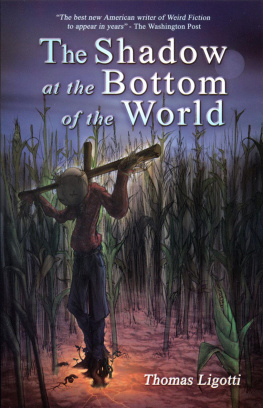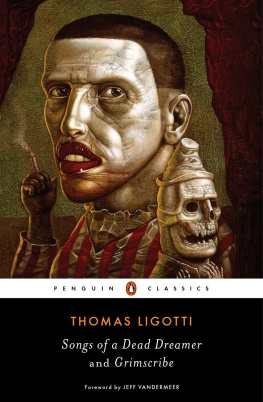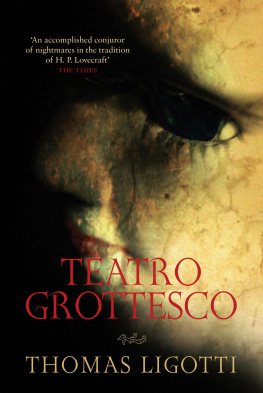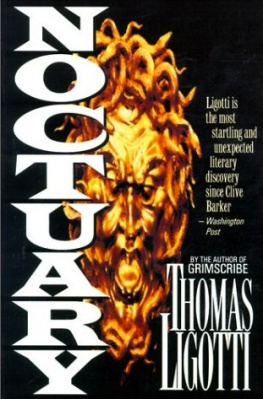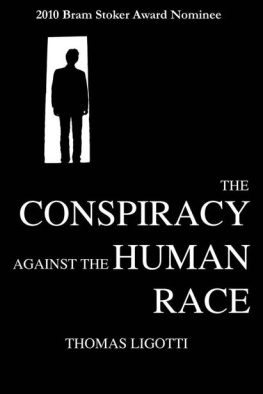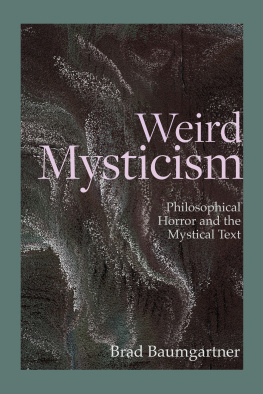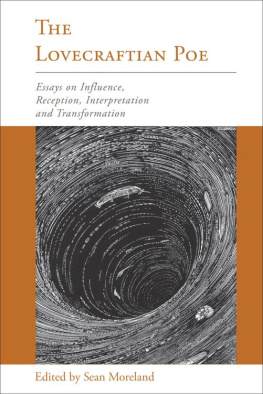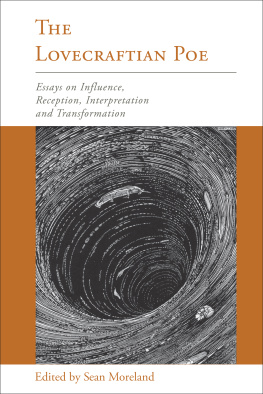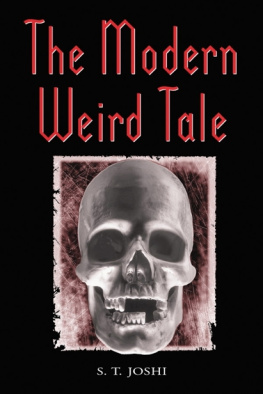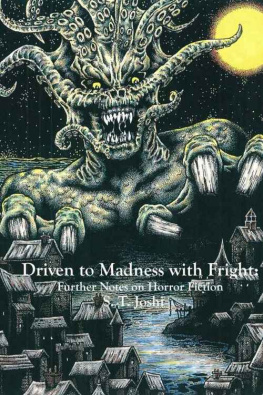The Shadow At the Bottom of the World
Thomas Ligotti is an absolute master of supernatural horror and weird fiction, and a true original. He pursues his unique vision with admirable honesty andrigorousness and conveys it in prose as powerfully evocative as any writer in the field. Id say he might just be a genius.
Ramsey Campbell
Songs of a Dead Dreamer
Grimscribe: His Lives and Works
Noctuary
The Agonizing Resurrection of Victor Frankenstein & Other Gothic Tales The Nightmare Factory
In a Foreign Town, In a Foreign Land
I Have a Special Plan for This World
This Degenerate Little Town
My Work Is Not Yet Done: Three Tales of Corporate Horror Crampton
Death Poems
Foreword by Douglas A. Anderson
Cold Spring address
P.O. Box 284, Cold Spring Harbor, NY 11724 E-mail: Jopenroad@aol.com Copyright 2005 by Thomas Ligotti
Foreword copyright 2005
by Douglas A. Anderson
ISBN 1-59360-058-5 Library of Congress Control No. 2005928861
- All Rights Reserved Printed in the United States of America Horror Stories: A Nightmare Scenario copyright 2005 by Thomas Ligotti Stories from Songs of a Dead Dreamer, including Dr. Voke and Mr. Veech,
Alices Last Adventure, Vastarien, and Dr. Locrians Asylum, copyright 1989 by Thomas Ligotti
Stories from Grimscribe, including The Last Feast of Harlequin, The Mystics of Muelenburg, The Spectacles in the Drawer, The Shadow at the Bottom of the World, Nethescurial, and The Cocoons, copyright 1991 by Thomas Ligotti Stories from Noctuary, including The Strange Design of Master Rignolo and The Tsalal, copyright 1994 by Thomas Ligotti Stories from The Nightmare Factory, including The Bungalow House, Teatro Grottesco, and The Red Tower, copyright 1996 by Thomas Ligotti Purity copyright 2003 by Thomas Ligotti 5
To the memory of my uncles Leonard Ligotti and Joseph Mazzo.
Contents
Foreword by Douglas A. Anderson 8
Introduction: Horror Stories: A Nightmare Scenario by Thomas Ligotti 10
The Last Feast of Harlequin 17
Dr. Voke and Mr. Veech 53
Alices Last Adventure 63
Vastarien 80
Dr. Locrians Asylum 94
The Mystics of Muelenburg 104
The Spectacles in the Drawer 112
The Strange Design of Master Rignolo 124
The Shadow at the Bottom of the World 135
Nethescurial 144
The Cocoons 158
The Tsalal 168
The Bungalow House 196
Teatro Grottesco 216
The Red Tower 234
Purity 244
Foreword
In the historical development of the artistic horror story, there are three major figures. The first is, of course, Edgar Allan Poe (1809-1849), the father of the modern psychological horror story. The next, chronologically, is H. P. Lovecraft (1890-1937), who brought cosmicisman awareness of the vastness of the universe and of the insignificance of the human race to the weird tale. And now there is Thomas Ligotti (b. 1953), who has extended Lovecrafts cosmicism by suggesting that an inescapable malignancy and nightmare inheres in all existence, manifesting itself in both the individual psyche and the physical cosmos. Interestingly, these three writers have found the short story rather than the novel to be their ideal vehicle for expression.
For Ligotti, the short story allows a purer and more intense expression of horror than do novels.
Born in Detroit, Ligotti grew up in a nearby suburb and in 1977 graduated from Wayne State University with a B.A. in English. From 1979 to 2001 he worked in the literary criticism division of the Gale Research Company (now Thomson Gale), a publisher of reference books. Ligotti then moved to Florida, where he makes his living as an editorial freelancer.
He began writing horror fiction around 1976, and published his first short story in 1981. His first book, a small press collection entitled Songs of a Dead Dreamer, came out in an edition of 300 copies in 1985. Today it is a highly-prized rarity. An expanded edition appeared from a trade publisher in 1989, followed by further collections: Grimscribe (1991), Noctuary (1994), and the omnibus volume The Nightmare Factory (1996). Since then Ligotti has worked mostly with small publishers, like Durtro Press, which has issued elegant limited editions like In a Foreign Town, In a Foreign Land (1997), a collection of four
interconnected stories; an unproduced screenplay, Crampton (2002), written in collaboration with Brandon Trenz; and some small books of Ligottis verse, I Have a Special Plan for This World (2000), This Degenerate Little Town (2001), and Death Poems (2004).
In 1994, Silver Salamander Press collected Ligottis vignettes in The Agonizing Resurrection of Victor Frankenstein & Other Gothic Tales. Another small press, Mythos Books, has published My Work Is Not Yet Done: Three Tales of Corporate Horror (2002), whose eponymous story is Ligottis lengthiest tale. Forthcoming from Mythos Books is Ligottis long essay, The Conspiracy Against the Human Race: On the Horror of Life and the Art of Horror, a kind of personal credo of Ligottis views on life and literature. The two main websites devoted to Ligottis work are Thomas Ligotti Online (www.ligotti.net) and The Art of Grimscribe (www.ligotti.de.vu). Both websites have a complete Ligotti bibliography, and much else of interest.
The stories in this volume were selected by Ligotti and myself as an introductory sampler of his works. They are arranged in the order in which they were written. Thus, The Least Feast of Harlequin which Ligotti has referred to as the first story he wrote that he thought was good enough not to throw awayopens the collection, and Purity, one of his most recent tales, concludes it. The bulk of these stories, however, date from the late 1980s and early 1990s, Ligottis most productive period.
Unlike the bulk of horror fiction past and present, Ligottis work is essentially outside the tradition of strict realism in which a neatly demarcated natural world is threatened by a supernatural menace, an aberration in the normal course of things that more often than not maybe combated and conquered.
In the universe of Ligottis fiction, the natural and the supernatural merge into the same nightmare; to distinguish them is meaningless and no salvation is to be found in this world or any other. As Ligotti has noted, many of his stories focus on those anomalous moments in which a characters perception of his world is shaken and he is forced to confront a frightening and essentially chaotic universe. Which is, in its way, a realism of the highest order.
Douglas A. Anderson
Introduction
HORROR STORIES: A NIGHTMARE SCENARIO
Extracted from the forthcoming book, The Conspiracy against the Human Race: On the Horror of Life and the Art of Horror.
For a horror story to be effective, it must both reflect and deform the world we know, the place in which we eat and fight and procreate. This means that it must not intrude on the sacred ground already being worked by established institutions of faith, which at some point inevitably deviate into the unknowable in order to comfort their audience rather than distress them. Should it follow this craven path, the horror story would lose its greatest valuethe power to convey truths that have currency with respect to our evolving trepidations rather than perpetuating some primitive lore of the remote past. A literary law that only the greatest writers in the genre, such as Edgar Allan Poe and H. P. Lovecraft, have followed in their writings maybe stated as follows: No horror tale shall take advantage of its readers by playing upon their religious beliefs. This is an easy and a vile game that only the lowest form of scribe would perpetrate on those who already have their heads filled with all kinds of fears conditioned into them since they were children in the hands of an angry god. Fortunately, we find that a model for creating horror has been provided for us that has nothing to do with preachers and pulpits and the puppetry of doctrinal compliance. This model is given to us in the form of nightmares, which conform to no orthodoxies except those of our developing fears. No bad dream ever ended with its dreamer finding salvation from his minds hell. Such finales are always invented after the fact by storytellers with a redemptive agenda.
Next page
